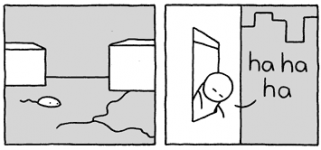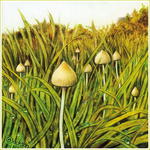|
|
Results 51 to 75 of 84
-
07-25-2009 01:04 AM #51Member Achievements:




- Join Date
- Mar 2008
- Gender

- Posts
- 354
- Likes
- 0
I made very little changes, and I just wanted to do something.
 Mainly, I tried to change the flow a tiny bit.
Mainly, I tried to change the flow a tiny bit.
Spoiler for My revision of very litte changes, V 2.35 :
-
07-25-2009 02:09 AM #52Hero Of Dreams



- Join Date
- Feb 2009
- LD Count
- 8
- Gender

- Location
- Scotland
- Posts
- 328
- Likes
- 58
- DJ Entries
- 11
-
07-25-2009 02:20 AM #53Banned

- Join Date
- Apr 2009
- Gender

- Location
- Oregon...
- Posts
- 826
- Likes
- 22
Spoiler for V. 2.37:
i know im not in the edit department but w/eLast edited by Banana; 07-25-2009 at 02:27 AM. Reason: added a comma
-
07-25-2009 02:21 AM #54
The reason why I edited so much was because I wanted to eliminate the use of 'may,' it was killing the narrative. I think it was fine where DoD had it. Sorry guys.

Starry starry night, paint your pallet blue and gray,
Look out on a summers day,
with eyes that know the darkness of my soul.
-
07-25-2009 02:47 AM #55Member Achievements:




- Join Date
- Mar 2008
- Gender

- Posts
- 354
- Likes
- 0
Hey, I tried.
Last edited by Exhalent; 07-25-2009 at 02:51 AM.
-
07-25-2009 02:52 AM #56of dreaming


- Join Date
- Jan 2009
- LD Count
- 6 WILD 29 DILD
- Gender

- Location
- My Brain and sometimes the Pac-NW
- Posts
- 517
- Likes
- 5
OK, yeah wow. Thanks everyone. I'll go over these new versions and see what we can use.
Just a little note - If a piece has obviously been edited by several people then it's probably best to move on to another. We don't want to keep nitpicking a piece apart to death
I'll post a final draft this weekend. Thanks again!!!!
-
07-25-2009 07:06 PM #57
When ever you think you can add something to the piece

Good work guys, looks awesome
-
07-25-2009 07:50 PM #58IMPORTANT - ALL EDITING STAFF PLEASE READ
I think you all are doing a fantastic job but I'm not entirely sure why Banana's post was in here for editing when he's not currently writing a chapter nor is there any guarantee that that post will be used at all. Originally, Naiya wanted other writers to help aid the main authors of the chapters currently being written (those being chapters two and three). If that post was created with the intent of aiding the authors of chapters two and three then it should have been placed in the chapter writing department first before it went to revisions. Once again, presupposing it was created to aid them, Naiya or ca1um132 would have then said something about its relevancy before the post went to revisions.
This is just so we won't be wasting the editors time having them edit information that the authors at this time were unaware about
In the future, perhaps someone should approve a post (that needs editing) before it gets sent to the revisions department.
Banana, this is not to say that you are doing a bad job at all, hell no. If that post was meant to help the authors of 2 and 3 then you're doing as Naiya asked (by working on chapters together as a whole). If that post was meant to be independent of the currently active chatpers then that's going against what she has asked and the editing department staff basically edited a post that may not be used at all.
I propose that all original submitted works thought relevant to "active" chapters, be posted in the writing department for the author(s) of the active chapter(s) to approve or disapprove of that work in the sense of it being useful and whether it should be sent to revisions and then BACK to the writing department...or not. What say you?Last edited by Jeff777; 07-25-2009 at 08:19 PM.
Things are not as they seem
-
07-25-2009 08:08 PM #59Banned

- Join Date
- Apr 2009
- Gender

- Location
- Oregon...
- Posts
- 826
- Likes
- 22
Ok, jeff thats fine.
I just thought it wouldd be a good idea to get that one started but w/e
I guess ill start working on helping with the active chapters.
-
07-25-2009 08:10 PM #60of dreaming


- Join Date
- Jan 2009
- LD Count
- 6 WILD 29 DILD
- Gender

- Location
- My Brain and sometimes the Pac-NW
- Posts
- 517
- Likes
- 5
YES Thank you Jeff!!
You said it better than I could. I was thinking the same thing and was confused on where exactly Banana's post would be used.
Let's all do as Jeff said; once a work has been approved by one of the writers THEN it can go to Editing/Revising for us to correct as we find necessary.
Thank you again for the clarification. If any of you have any questions don't hesitate to PM Jeff, myself or CB.
Thanks!!
-
07-26-2009 09:00 AM #61
I'm reporting in.
I feel horribly behind in all of this.
What exactly should I be editing/Where do I go to find things to edit?
-
07-26-2009 07:23 PM #62
Lol you're just fine Moosey. Work that needs editing will be posted in here after it's been approved for editing by the authors of whatever chapter(s) are active at this time.
By active, I mean being written. Currently chapters 2 and 3 are being written and the authors of those chapters are ca1um132 and Naiya.
If there are any tasks/work the Department Leader's in here (dreamingofdreaming and CoLd BlooDed) may need completed aside from the work being written, they'll say so in here or PM you.
To the best of my knowledge, there currently isn't any work pending. But just to be sure, check with DoD and CB.
p.s.: When Naiya and ca1um132 post the rough drafts of their chapters, there will be a lot more work in here to do.Last edited by Jeff777; 07-26-2009 at 09:32 PM.
Things are not as they seem
-
07-26-2009 09:05 PM #63
Oh all righty. I was scared that there was a lot of work to do and I wasn't helping at all.
Thanks Jeffy.

-
07-29-2009 06:04 PM #64of dreaming


- Join Date
- Jan 2009
- LD Count
- 6 WILD 29 DILD
- Gender

- Location
- My Brain and sometimes the Pac-NW
- Posts
- 517
- Likes
- 5
^ ^ Thanks again Moosey

Hey all! It's been a slow week for this department as all our fabulous researchers and writers are scrambling their brains together to get some good drafts for us to look at... We should have stuff up shortly.
Spoiler for A little side note:
I hope to see the rest of the folks in this department checking in before the week is out!!!
<3 dreamingofdreaming
-
07-30-2009 02:37 AM #65
Here.

Starry starry night, paint your pallet blue and gray,
Look out on a summers day,
with eyes that know the darkness of my soul.
-
08-05-2009 07:47 AM #66
-
08-05-2009 09:01 AM #67Spoiler for Minor changes v.1.0:
I want you fancy cats to go over this in case I've missed something or you feel that the flow could be better.

-
08-05-2009 09:10 AM #68
I will go over this thoroughly in the next couple days.

Starry starry night, paint your pallet blue and gray,
Look out on a summers day,
with eyes that know the darkness of my soul.
-
08-05-2009 12:24 PM #69Master of Logic Achievements:








- Join Date
- Feb 2007
- Gender

- Location
- Some rocky planet with water
- Posts
- 3,993
- Likes
- 90
Wah. Please don't flame me. I've expanded the text vertiginously. Also made a few correction for a better flowing style. Corrected some outdated information which was in the chapter I originally wrote, and finally, added stuff on the purpose of dreams.
Spoiler for Expansion:
Also, I wonder if we should do the editing on the actual thread of the chapter. This would be to avoid parallel works among the departments.
Finally, we need images for this chapter, specifically about the sleep stages.Last edited by Kromoh; 08-05-2009 at 08:47 PM. Reason: typos

Saying quantum physics explains cognitive processes is just like saying geology explains jurisprudence.
-
08-05-2009 05:10 PM #70Motion Personified Alpha Achievements:






- Join Date
- Apr 2009
- Gender

- Location
- United Kingdom
- Posts
- 1,053
- Likes
- 58
- DJ Entries
- 1
-
08-05-2009 05:20 PM #71Master of Logic Achievements:








- Join Date
- Feb 2007
- Gender

- Location
- Some rocky planet with water
- Posts
- 3,993
- Likes
- 90
Not sure what exactly. That old graph showing the sleep stages during the night for sure (know what one?), but I can't think of what else. I don't know how far we'll be going with images, but a pic of a man sleeping and dreaming he is walking would be good to illustrate LaBerge's theory of dreams. There is also this graph showing how people that slept after learning something new memorized it better, dunno how hard it would be to find it.

Saying quantum physics explains cognitive processes is just like saying geology explains jurisprudence.
-
08-05-2009 09:10 PM #72DV Buddy: BlueKat
-
08-05-2009 09:36 PM #73
-
08-06-2009 05:19 AM #74
Aww! You did a great job Kromoh! Thank you so much. I will definitely put your name down with mine for this chapter since you put so much work into it.

There's another thing I have to fix in there, though, which is this:
When that's done I'll repost it in its own thread for more editing.
Keep in mind this was the first draft and just the first part, so the rest will need editing when it's done.DV Buddy: BlueKat
-
09-04-2009 08:19 PM #75
Hey guys, more of Chapter 3 has been up for a while. Is there anyone willing to proofread it for me? Thanks.
 DV Buddy: BlueKat
DV Buddy: BlueKat




 LinkBack URL
LinkBack URL About LinkBacks
About LinkBacks




 Reply With Quote
Reply With Quote



Bookmarks